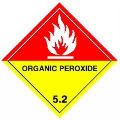Lycanthrope:
Help! Can someone remind me the basics of what to do with 5.1 / 5.2.
Hi Lycanthrope, OK, here goes. Even though you don’t now need it.


 The headmaster would like to know how you lost your schoolbook
The headmaster would like to know how you lost your schoolbook 


These substances and articles contain oxygen and are therefore capable of starting or supporting fires, even in enclosed spaces, when they come into contact with something capable of being burned. (Fuel.)
Some oxidisers have a secondary hazard, such as corrosivity. Some 5.1s are a liquid, whilst some other 5.1s are a solid.
PPE for class 5.1 will include protection for your skin (people count as fuel  ) and eyes, so goggles and gloves will be the minimum, but the appropriate level of protection will be written on your Instructions In Writing (Tremcard.)
) and eyes, so goggles and gloves will be the minimum, but the appropriate level of protection will be written on your Instructions In Writing (Tremcard.)
Oxidisers conform to the notion of packing groups (PGs) where
PGI = high danger
PGII = medium danger
PGIII = low danger
5.1s are assigned to packing groups dependant on their oxygen content and how easily / quickly they release the oxygen.
5.1s must not be carried near to any other dangerous goods that have a flame symbol on the label, therefore adequate segregation should be implemented in such a case.
As with any other dangerous goods, 5.1s must be correctly contained and secured in order to prevent accidental human contact and/or damage to the environment.

 New 5.2
New 5.2
Organic Peroxides are similar to Oxidisers in that they contain oxygen, but 5.2s come with their own fuel too. 
To say that 5.2s are sensitive to heat is an understatement. 
If you remember the fire triangle, you’ll see that chemically, 5.2s are living life right on the edge.
Due to the sensitivity of most 5.2s, they do not fit the notion of packing groups, but instead are assigned to one of seven bands of danger, these being expressed using the letters A - G.
5.2s all end up in Transport Categories, with ADR load “trigger” limits, just like other dangerous goods, but they are placed in the transport category by their specific UN number. As a rough rule of thumb, most 5.2s are in transport category 1, whilst the rest are in transport category 2.
Some 5.2s are so sensitive that they must have an explosive label as a secondary hazard.  In most cases of this type, the load must legally be carried in a fridge truck. 5.2s are one of the few classes that, in some cases, also have an upper load limit per vehicle. (Like explosives.)
In most cases of this type, the load must legally be carried in a fridge truck. 5.2s are one of the few classes that, in some cases, also have an upper load limit per vehicle. (Like explosives.)
Another possible secondary hazard of 5.2s is that they might also be corrosive.
5.2s should also be segregated from any other dangerous goods that have a flame symbol in the top half of their label.
The PPE requirement for 5.2s is much the same as for 5.1s, but there is EXTREME danger for eyes in contact with any 5.2 substance.
A little not about the 5.2 labels. On 01/01/07, a new label came out for 5.2s. This has the appearance of the bottom half of the old label, combined with the top half of a class 3 label. The old (all yellow) label may continue to be unsed until 31/12/10, so you might see either kind. Please don’t get confused, because they both have the same meaning.
Spill kits for classes 5.1 and 5.2 must be as per the Instructions In Writing as a MINIMUM, so anything you have over and above that is just fine.
I hope this helps. 
To animal: Thanks for letting me know. 

![]() Looked everywhere but can’t find my core modules coursebook either.
Looked everywhere but can’t find my core modules coursebook either.![]()


 New 5.2
New 5.2